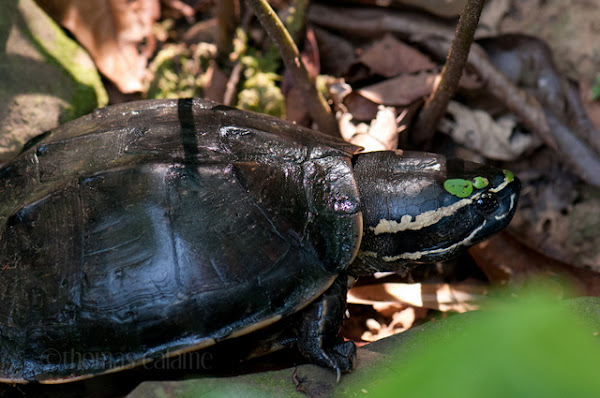Malayemys khoratensis (Khorat Snail-Eating Turtle)
The common name of this Freshwater Turtle in English is commonly called Khorat Snail-eating Turtle, Isan Snail-eating Turtle and Thai name called เต่านาอีสาน (Dtao Na Isan), เต่านาโคราช (Dtao Na Khorat).

Source: iNaturalist.org; Malayemys khoratensis Ihlow et al. 2016. Photo by Thomas Calame. (CC BY-NC)
เต่านาอีสาน : Malayemys khoratensis Ihlow, Vamberger, Flecks, Hartmann, Cota, Makchai, Meewattana, Dawson, Kheng, Rödder & Fritz, 2016
Malayemys khoratensis is a species of the Snail-eating Turtle Genus (Malayemys) within the Freshwater Pond Turtle Family (Geoemydidae), Superfamily Testudinoidea, in the Suborder Cryptodira, in the Turtles Order (Testudines), in the Reptile Class (Reptilia), in the Chordate Phylum (Chordata) in the Animal Kingdom (Animalia).
Published in Ihlow, F., Vamberger, M., Flecks, M., Hartmann, T., Cota, M., Makchai, S., Meewattana, P., Dawson, J.E., Kheng, L., Rödder, D., Fritz, U. (2016) Integrative Taxonomy of Southeast Asian Snail-eating Turtles (Geoemydidae: Malayemys) unravels a new species and mitochondrial introgression. –PLoS One, DOI: 10.1371/journal.pone.0153108.
The specific epithet 'khoratensis' meaning to the Khorat Basin, the watershed to which the range of the new species appears to be restricted.
Geographic Range
This species is endemic to the western Khorat Plateau in Thailand and might occur throughout the entire plateau. It might also be present on the other side of the Mekong River in Lao People's Democratic Republic (Ihlow et al. 2016).
Habitat and Ecology
It inhabits seasonally flooded habitats, including rice fields.
Type locality: “Udon Thani, Udon Thani Province, Thailand (17.36555°N, 102.81427°E)”
The species is used for merit-making ceremonies (capture and then release).
Diagnosis
Malayemys species with a straight carapace length below 20 cm and a tricarinate, blackish-brown carapace, and a blackish-brown head with distinct yellowish facial stripes. Malayemys khoratensis differs from M. macrocephala by the following characters:
- first ver- tebral scute roughly square and not tapered posteriorly (V1W/V1L: 0.83±0.09 vs. 0.74±0.19 in females, 0.83±0.12 vs. 0.69±0.09 in males);
- lower marginal scutes 8–12 with a pattern of diagonal to cone-shaped blackish brown blotches originating from the outer posterior corner vs. narrow blackish-brown bars at the posterior sutures;
- infraorbital stripe not or rarely reaching the loreal seam, not broadened at the suture vs. always reaching the loreal seam and usually distinctly broadened at the suture;
- infraorbital stripes only slightly curved below of tyrosine (T) at positions 111, 387, 388,615, 616 of the 1078-bp-long reference alignment of the cyt b gene (S1 FASTA).
Synonym
- Malayemys subtrijuga Bryan L. Stuart & Steven G. Platt (2004)
- Malayemys subtrijuga Kubota et al. (2015)
- Malayemys isan Montri Sumontha, Timothy R. Brophy, Kirati Kunya, Suthep Wiboonatthapol & Olivier Sylvain Gérard Pauwels (2016)
- Malayemys khoratensis Flora Ihlow, Melita Vamberger, Morris Flecks, Timo Hartmann, Michael Cota, Sunchai Makchai, Pratheep Meewattana, Jeffrey E. Dawson, Long Kheng, Dennis Rödder & Uwe Fritz (2016)
Comment: Malayemys isan was described in a paper published on 26 March 2016 while that of M. khoratensis was published on 6 April 2016. The two species are synonymous based on O. Pauwels, pers. comm., 9 April 2016. TTWG 2017 decided to give khoratensis priority as isan did not comply with ICZN rules (Zoobank registration) of online publications. This was confirmed by Thomson & Lambertz 2017.